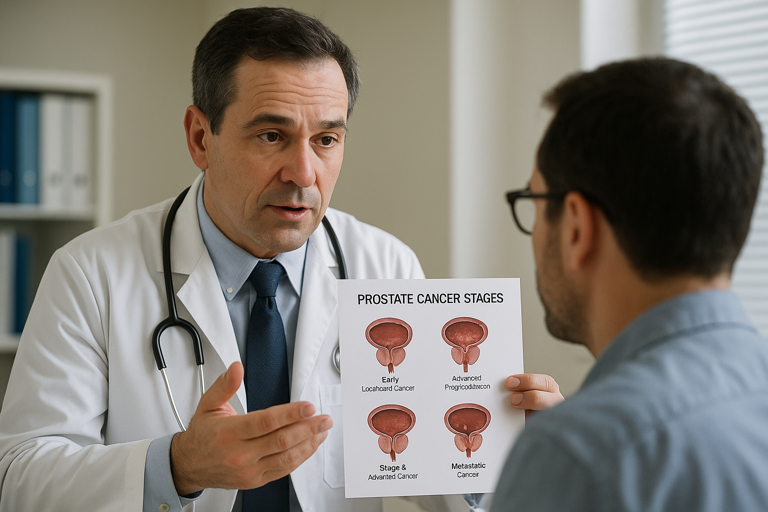
Prostate cancer is one of the most common cancers affecting men worldwide. Early diagnosis and treatment are key to improving survival rates. But how can you fully understand the progression of prostate cancer? The answer lies in understanding the different prostate cancer stages. These stages help doctors determine the severity of the disease and tailor treatment plans accordingly. In this article, we’ll walk through the various stages of prostate cancer, what they mean, and how they influence treatment decisions.
Table of Contents
- What Are Prostate Cancer Stages?
- Stage 1: Early and Localized Prostate Cancer
- Stage 2: Prostate Cancer Growth and Progression
- Stage 3: Advanced Prostate Cancer
- Stage 4: Metastatic Prostate Cancer
- Conclusion
- FAQs
What Are Prostate Cancer Stages?
Prostate cancer stages are essential for doctors to understand the extent of cancer’s spread in the body. These stages range from localized cancer, where the tumor is confined to the prostate, to metastatic cancer, where cancer cells have spread to other parts of the body. The staging helps determine the most effective treatment plan and whether the cancer is likely to recur.
In the early stages, prostate cancer may show few to no symptoms. However, as the disease progresses, it can affect other organs, making treatment decisions more complicated. The stages of prostate cancer are determined using a combination of tests, including biopsy results, imaging, and PSA (prostate-specific antigen) levels.
Stage 1: Early and Localized Prostate Cancer
At Stage 1, prostate cancer is confined entirely to the prostate gland. It is often referred to as localized cancer because it hasn’t spread to other parts of the body. In this stage, tumors are generally small and can be difficult to detect without a biopsy. Doctors usually discover this stage of cancer through routine screening, such as a PSA test or a digital rectal exam (DRE).
Since the tumor is localized, the chances of successful treatment are high, and many men can live for years with this diagnosis. Treatment options typically include active surveillance, surgery (such as prostatectomy), or radiation therapy. Surgery aims to remove the prostate, while radiation uses high-energy rays to target and destroy cancer cells.
While prostate cancer at this stage is not life-threatening, regular monitoring is crucial to track the tumor’s growth and any potential changes.
Stage 2: Prostate Cancer Growth and Progression
In Stage 2, the cancer has grown larger, but it is still confined to the prostate. There are two subcategories of Stage 2 cancer: Stage 2A and Stage 2B. In both cases, the cancer is still localized, but it may have grown to affect a larger portion of the prostate.
Stage 2 is often considered an intermediate stage. While the cancer hasn’t spread to other organs, it’s growing at a faster rate. This stage may be detected via a biopsy, as tumors may be large enough to be found on imaging tests, such as an MRI or CT scan. PSA levels often rise in Stage 2, which can serve as a warning sign.
Treatment for Stage 2 prostate cancer usually involves surgery, radiation, or a combination of both. Doctors may also consider hormone therapy, such as GnRH agonists like Lupron, to shrink the tumor before surgery or radiation.
Patients diagnosed at Stage 2 are generally still in good health and have a favorable prognosis. However, the risk of recurrence becomes higher as the cancer grows. For this reason, doctors typically recommend active treatment to prevent further progression.
Stage 3: Advanced Prostate Cancer
Stage 3 prostate cancer represents a more advanced stage of the disease, as the cancer has begun to spread outside the prostate. It may invade the nearby seminal vesicles or other tissues in the pelvic area. However, it has not yet spread to distant organs such as bones or lymph nodes.
At this stage, the cancer is often aggressive and may cause more noticeable symptoms, such as difficulty urinating, blood in the urine, or pain in the pelvic region. PSA levels tend to be higher in Stage 3, and doctors will use various tests to monitor the extent of the spread. Imaging tests, including bone scans and CT scans, can help determine if the cancer has reached other organs.
Treatment for Stage 3 cancer may include surgery, radiation, and hormone therapy. Many doctors recommend a combination of treatments, as the cancer has a higher likelihood of recurrence or progression. Chemotherapy may also be an option if the cancer is particularly aggressive.
Although Stage 3 cancer is more advanced, many patients can still have a good prognosis with proper treatment. Continued monitoring is essential for identifying any signs of recurrence or metastasis.
Stage 4: Metastatic Prostate Cancer
Stage 4 is the most advanced stage of prostate cancer, where the cancer has spread beyond the prostate to other parts of the body, such as the bones, lymph nodes, or organs. This stage is also known as metastatic prostate cancer, and it requires intensive treatment.
At Stage 4, patients may experience more severe symptoms, such as bone pain, unexplained weight loss, and fatigue. Treatment is focused on managing the cancer, relieving symptoms, and improving the patient’s quality of life. It may include chemotherapy, hormone therapy, immunotherapy, and targeted therapy. Medications such as Zytiga (abiraterone) and Xtandi (enzalutamide) may be prescribed to slow the cancer’s progression by targeting androgen receptors.
While metastatic prostate cancer is challenging to treat, advances in medical treatments, such as immunotherapy and precision medicine, offer new hope. Clinical trials are an option for patients seeking cutting-edge treatments and therapies.
Prognosis for Stage 4 prostate cancer depends on various factors, including the patient’s age, overall health, and how well the cancer responds to treatment. Although Stage 4 cancer is more difficult to manage, many patients live for several years with the disease.
Conclusion
Understanding the stages of prostate cancer is vital for patients and their healthcare providers to determine the best course of action. Early-stage prostate cancer, when caught early, has a high success rate with treatment. As the cancer progresses, treatment options become more complex and involve a combination of therapies. Regardless of the stage, ongoing research and innovative treatments continue to improve the outlook for prostate cancer patients.
If you or a loved one has been diagnosed with prostate cancer, consult with your healthcare provider for a personalized treatment plan. For more information on managing prostate cancer and other health-related topics, visit Health.HealingWell.com.
FAQs
1. What are the signs of prostate cancer in its early stages?
In the early stages, prostate cancer may show no noticeable symptoms. Routine screenings like PSA tests and digital rectal exams are vital for detection.
2. Can prostate cancer be cured in the early stages?
Yes, prostate cancer is highly treatable in its early stages, especially if it’s confined to the prostate and detected early.
3. What are the treatment options for Stage 4 prostate cancer?
Stage 4 prostate cancer may require chemotherapy, hormone therapy, immunotherapy, or targeted therapies such as Zytiga and Xtandi.
4. How is prostate cancer staged?
Doctors use a combination of biopsy results, PSA levels, and imaging tests (like CT and MRI scans) to determine the stage of prostate cancer.
5. Is prostate cancer always fatal?
No, many men live with prostate cancer for years, especially if it is caught early and treated appropriately.
Disclaimer
This content is not medical advice. For any health issues, always consult a healthcare professional. In an emergency, call 911 or your local emergency services.




